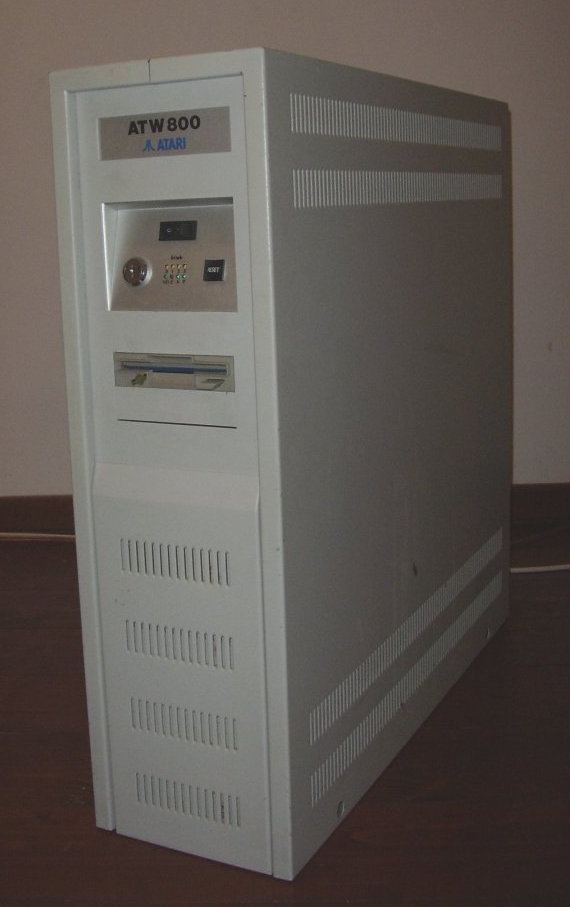Operating system | Units shipped 350 | |
 | ||
Also known as ATW-800, or ATW, or Abaq Release date May 1989; 27 years ago (1989-05) CPU 20 MHz T800-20 transputer | ||
The Atari Transputer Workstation (also known as ATW-800, or simply ATW) was a workstation class computer released by Atari Corporation in the late 1980s, based on the INMOS transputer. It was introduced in 1987 as the Abaq, but the name was changed before sales began. Sales were almost non-existent, and the product was canceled after only a few hundred had been produced.
Contents
History
In 1986 Tim King left his job at MetaComCo, along with a few other employees, to start Perihelion Software in England. There they started development of a new parallel-processing operating system known as "HeliOS". At about the same time a colleague, Jack Lang, started Perihelion (later Perihelion Hardware) to create a new transputer based workstation that would run HeliOS.
While at MetaComCo, much of the Perihelion Software team had worked with both Atari Corp. and Commodore International, producing ST BASIC for the former, and AmigaDOS for the latter. The principals still had contacts with both companies. Commodore had expressed some interest in their new system, and showed demos of it on an add-on card running inside an Amiga 2000. It appears they later lost interest in it. It was at this point that Atari Corp. met with Perihelion and work started on what would eventually become the ATW.
The machine was first introduced at the November 1987 COMDEX under the name Abaq. Two versions were shown at the time; one was a card that connected to the Mega ST bus expansion slot, the second version was a stand-alone tower system containing a miniaturized Mega ST inside. The external card version was dropped at some point during development. It was later learned that the "Abaq" name was in use in Europe, so the product name was changed to ATW800. Perihelion remained the exclusive distributor in England. A first run of prototypes was released in May 1988, followed by a production run in May 1989. In total only 350 machines were produced (depending on the source either 50 or 100 of the total were prototypes).
The team in charge of the ATW's video system, "Blossom", would later work on another Atari project, the Atari Jaguar video game console.
Description
The ATW system consisted of three main parts:
- the main motherboard containing a T800-20 transputer and 4MB of RAM (expandable to 16MB)
- a complete miniaturized Mega ST acting as an I/O processor with 512kB of RAM
- the Blossom video system with 1MB of dual-ported RAM
All of these were connected using the transputer's 20 Mbit/s processor links. The motherboard also contained three slots for additional "farm cards" containing four transputers each, meaning that a fully expanded ATW contained 13 transputers. Each ran at 20 MHz (the -20 in the name) which supplied about 10 MIPS each. The bus was also available externally, allowing several ATWs to be connected into one large farm. The motherboard also included a separate slot for one of the INMOS crossbar switches to improve inter-chip networking performance.
HeliOS was Unix-like, but not Unix. Of particular note was the lack of memory protection, due largely to the lack of an MMU on the transputer. This is not quite the issue it might seem, as the transputer's stack-based architecture makes an MMU less important. Meanwhile, HeliOS was Unix-like enough that it ran standard Unix utilities, including the X Window System as the machine's graphical user interface (GUI). In addition HeliOS ran on all of the transputers in a farm at "the same time", which allowed all computing tasks to be fully distributed. Turning off an ATW would not affect the overall farm, the tasks would simply move to other processors on other systems.
Blossom supported several video modes:
mode 0: 1280 by 960 pixels, 16 colours out of a palette of 4096 (including 16 true greyscales, on a monochrome monitor)mode 1: 1024 by 768 pixels, 256 colours out of a palette of 16.7 millionmode 2: 640 by 480 pixels (2 virtual screens), 256 colours out of a palette of 16.7 millionmode 3: 512 by 480 pixels, 16.7 million coloursWhile not much by today's standards, in the 1980s this was largely unheard of. Blossom also included a number of high-speed effects (128 megapixel fill rates) and blitter functionality, including the ability to apply up to four masks on a bit-blit operation in a fashion similar to a modern graphics processing unit's ability to apply several textures to a 3D object.
One oddity of the ATW is that it appears that the Blossom was responsible for the DRAM refresh, although the transputer included such hardware internally.
